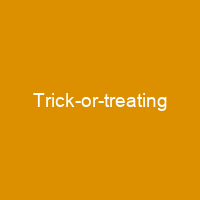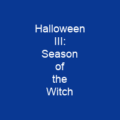Trick-or-treating is a traditional Halloween custom for children and adults in some countries. In the evening before All Saints’ Day, children in costumes travel from house to house, asking for treats with the phrase ‘Trick or treat’ In North America, trick-or.treating has been a Halloween tradition since the 1920s.
About Trick-or-treating in brief
 Trick-or-treating is a traditional Halloween custom for children and adults in some countries. In the evening before All Saints’ Day, children in costumes travel from house to house, asking for treats with the phrase \”Trick or treat\”. The \”treat\” is usually some form of candy, although in some cultures money is given instead. The \”trick\” refers to a threat, usually idle, to perform mischief on the homeowner or their property if no treat is given. Some homeowners signal that they are willing to hand out treats by putting up Halloween decorations outside their doors; others simply leave treats available on their porches for the children to take freely. In North America, trick-or.treating has been a Halloween tradition since the 1920s. In Scotland and other parts of Britain and Ireland, the tradition of going house to. house collecting food at Halloween goes back at least as far as the 16th century. There are many accounts from 19th-century Scotland and Ireland of people going house. to house in costume at Halloween, reciting verses in exchange for food, and sometimes. warning of misfortune if they were not welcomed. The ancient Greek writer Athenaeus of Naucratis records in his book The Deipnosophists that, in ancient times, the Greek island of Rhodes had a custom in which children would go from door-to-door dressed as swallows, singing a song, which demanded the owners of the house to give them food. The activity is prevalent in the United States, Canada, the United Kingdom, the Republic of Ireland, Australia, Puerto Rico, and northwestern and central Mexico.
Trick-or-treating is a traditional Halloween custom for children and adults in some countries. In the evening before All Saints’ Day, children in costumes travel from house to house, asking for treats with the phrase \”Trick or treat\”. The \”treat\” is usually some form of candy, although in some cultures money is given instead. The \”trick\” refers to a threat, usually idle, to perform mischief on the homeowner or their property if no treat is given. Some homeowners signal that they are willing to hand out treats by putting up Halloween decorations outside their doors; others simply leave treats available on their porches for the children to take freely. In North America, trick-or.treating has been a Halloween tradition since the 1920s. In Scotland and other parts of Britain and Ireland, the tradition of going house to. house collecting food at Halloween goes back at least as far as the 16th century. There are many accounts from 19th-century Scotland and Ireland of people going house. to house in costume at Halloween, reciting verses in exchange for food, and sometimes. warning of misfortune if they were not welcomed. The ancient Greek writer Athenaeus of Naucratis records in his book The Deipnosophists that, in ancient times, the Greek island of Rhodes had a custom in which children would go from door-to-door dressed as swallows, singing a song, which demanded the owners of the house to give them food. The activity is prevalent in the United States, Canada, the United Kingdom, the Republic of Ireland, Australia, Puerto Rico, and northwestern and central Mexico.
It is believed to have pre-Christian roots. Among Celtic-speaking peoples, it was seen as a liminal time, when the spirits or fairies, and the souls of the dead, came into our world and were appeased with offerings of food and drink. It may otherwise have originated in a Celtic festival, held on 31 October–1 November, to mark the beginning of winter. People would visit houses and take soulcakes, either in return for praying for their souls, or taking soulcakes from parishioners under the windows to protect oneself from them. People impersonated spirits, and received offerings on their behalf. Seddle suggests they demanded reward for good fortune in the winter, who would exchange good fortune for good souls or Impersonating these spirits was also believed to be a way of protecting oneself from the evil spirits. People went to the parish to beg for soulcakes under some windows, such as under some such as the windows of some churches in the 15th century, and would sing a verse under the window to protect themselves from evil spirits, or to pray for their return. People in the Middle Ages would go to the Parish to ask for soul-cakes under the Parish windows, and if they did not give them, they would say ‘Help the Halloween Party’ People would then go to other houses and beg for food or money.
You want to know more about Trick-or-treating?
This page is based on the article Trick-or-treating published in Wikipedia (as of Dec. 05, 2020) and was automatically summarized using artificial intelligence.







